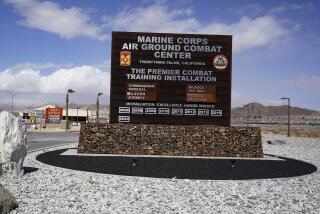Military Tries to Fast-Forward to Safety
- Share via
SEAL BEACH — Inside four unmarked, windowless trailers parked at the Naval Weapons Station, Marine reservists headed for Iraq are being taught how to survive the deadliest threat that awaits them: roads thick with hidden bombs, snipers and suicide vehicles.
One-third to one-half of U.S. fatalities and injuries in Iraq are inflicted by insurgent attacks on convoys -- a fact that has sent the military scrambling for ways to protect Army and Marine Corps troops.
Although much of the attention has been on retrofitting vehicles with armor plating, the Pentagon also has moved to upgrade predeployment training.
The latest wrinkle is a video simulation trainer that presents troops with scenarios they are very likely to confront when they move in convoys transporting troops and supplies.
Similar simulation trainers have long been used for tanks and Bradley Fighting Vehicles, as well as attack aircraft and helicopters. Even submarines have simulation trainers.
But until the Iraq insurgency began to target convoys with deadly results, the idea of a simulation trainer for Humvees was not a priority.
Military training had not kept pace with the real-world threats posed to troops sent to Iraq.
“We find ourselves in a kind of training crisis,” said Army Maj. Ted Perryman, with the Army’s simulation, training and instrumentation command in Orlando, Fla.
“War evolves, and you have to adapt,” said Marine Lt. Col. Julio B. Villalba, program manager for training systems.
Last spring the Pentagon challenged U.S. high-technology firms to develop a simulation trainer for Humvees.
Although there have been smaller simulation efforts at individual bases, military planners decided it was time to spread the training throughout the services.
By June, two Florida-based companies, Raydon and the simulation and training division of Lockheed Martin -- had been given contracts to develop convoy simulation trainers -- virtual lightning speed for the Pentagon’s bureaucracy-laden procurement system.
So far, the Pentagon has spent more than $25 million on the convoy project. Depending on an evaluation this summer, the Pentagon might order more trainers for more bases.
By August, the Lockheed Martin trainers had been delivered to Ft. Sill and Ft. Campbell Army bases. Now the company’s units for the Marine Corps are being delivered.
The four trailers here are being used by Marines from the 5th Battalion, 14th Regiment, a reserve unit based in Seal Beach that will deploy in coming months to Iraq.
This week, the trailers will be hitched to trucks and taken to Ft. Hunter-Liggitt in Central California to train Marine and Army troops and then to the Marine base at Twentynine Palms, where troops are preparing to return to Iraq early next year.
Inside each trailer is a mock-up of a Humvee and five large movie-style screens that provide a 180-degree environment. Troops “drive” along Iraqi streets and confront a variety of potential threats.
Computer technicians from Lockheed Martin and its subcontractor, Georgia-based Firearms Training Systems Inc., control what the screens show.
The videos are modeled after specific streets and roadways in Baghdad, the Sunni Triangle and other Iraqi locations.
The technicians can add explosions from roadside bombs, mortar fire, snipers firing from roofs and Iraqi civilians caught in the crossfire.
The goal is to see how well the troops inside each Humvee react as a team while maintaining communication with troops in the other Humvees in the convoy.
“We build the stress levels up,” said Lockheed executive Warren Wright. “We want to stress them with as much realism as we can within the limits of the system.”
Each troop has an ersatz weapon -- an M-16 or a 50-caliber machine gun -- designed to give the feel and recoil of a real weapon but to fire only laser beams.
The action is filmed so troops can evaluate their performance.
The mock-ups are stationary, but movement on the screens is fast and unpredictable.
The simulation includes sound effects, such as the roar of F/A-18s overhead if the troops call for air support.
Wind and rain can be added; scenarios can be day or night.
One goal is to teach troops the kinds of places where roadside bombs can be hidden.
“We can put in anything: artillery, trash cans, tires, rock piles, dead bodies, anything,” said Lockheed Martin technician Bob Smith.
On Thursday, the Marines were training on a scenario that simulated the streets of Tikrit. Insurgents set off roadside bombs to maneuver the Humvees into ambushes from small-arms fire.
The Humvees in the first and second trailers became separated. The level of confusion mirrored that of a war zone.
The simulation training is seen as a bridge between classroom lectures and live-fire exercises at Twentynine Palms.
The trainers will be particularly helpful for reservists who have not had the extensive field training of active-duty troops, Villalba said.
None of the reservists being trained on the Tikrit scenario has yet been to Iraq. But all have heard stories from buddies.
“I’ve had a lot of friends come back, and they’ve told me: You don’t know when they’re going to hit you,” Lance Cpl. Ryan Polizzi said.
“Guys have told us to expect to see action almost anytime you’re on the roads,” Pfc. Daniel Gabaldon said.
Army and Marine Corps training officers are bullish on the simulation trainers but said it’s impossible to predict whether the system will save lives.
“My gut tells me it will, absolutely,” Villalba said. “I’d rather they learn things here than over there, the hard way.”
More to Read
Sign up for Essential California
The most important California stories and recommendations in your inbox every morning.
You may occasionally receive promotional content from the Los Angeles Times.













